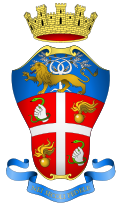| Commanding General of the Carabinieri | |
|---|---|
| Comandante generale dell'Arma dei Carabinieri | |
 Coat of arms of the Carabinieri | |
 Flag of the commanding general of the Carabinieri | |
| Ministry of Defence Carabinieri | |
| Reports to | The minister of defence |
| Seat | Rome, Italy |
| Nominator | The minister of defence |
| Appointer | The president of Italy |
| Formation | 3 August 1814 |
| First holder | Giuseppe Thaon di Revel di Sant'Andrea |
| Deputy | Army corps general Enzo Bernardini |
| Website | Carabinieri website |

This article lists the commanding generals of the Carabinieri , the national gendarmerie and a law enforcement agency of Italy. [1]
